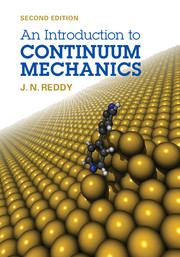Book contents
- Frontmatter
- Dedication
- Contents
- List of Symbols
- Preface to the Second Edition
- Preface to the First Edition
- About the Author
- 1 INTRODUCTION
- 2 VECTORS AND TENSORS
- 3 KINEMATICS OF CONTINUA
- 4 STRESS MEASURES
- 5 CONSERVATION AND BALANCE LAWS
- 6 CONSTITUTIVE EQUATIONS
- 7 LINEARIZED ELASTICITY
- 8 FLUID MECHANICS AND HEAT TRANSFER
- 9 LINEARIZED VISCOELASTICITY
- References for Additional Reading
- Answers to Selected Problems
- Index
5 - CONSERVATION AND BALANCE LAWS
Published online by Cambridge University Press: 05 July 2013
- Frontmatter
- Dedication
- Contents
- List of Symbols
- Preface to the Second Edition
- Preface to the First Edition
- About the Author
- 1 INTRODUCTION
- 2 VECTORS AND TENSORS
- 3 KINEMATICS OF CONTINUA
- 4 STRESS MEASURES
- 5 CONSERVATION AND BALANCE LAWS
- 6 CONSTITUTIVE EQUATIONS
- 7 LINEARIZED ELASTICITY
- 8 FLUID MECHANICS AND HEAT TRANSFER
- 9 LINEARIZED VISCOELASTICITY
- References for Additional Reading
- Answers to Selected Problems
- Index
Summary
Although to penetrate into the intimate mysteries of nature and thence to learn the true causes of phenomena is not allowed to us, nevertheless it can happen that a certain fictive hypothesis may suffice for explaining many phenomena.
— Leonard Euler (1707–1783)Nothing is too wonderful to be true if it be consistent with the laws of nature.
— Michael Faraday (1791–1867)Introduction
Virtually every phenomenon in nature can be described in terms of mathematical relations among certain quantities that are responsible for the phenomenon. Most mathematical models of physical phenomena are based on fundamental scientific laws of physics that are extracted from centuries of observations and research on the behavior of mechanical systems subjected to the action of natural forces. The most exciting thing about the laws of physics, which are also termed principles of mechanics, is that they govern biological systems as well (because of mass and energy transports). However, biological systems may require additional laws, yet to be discovered, from biology and chemistry to reasonably complete their descriptions.
This chapter is devoted to the study of fundamental laws of physics and resulting mathematical models as applied to mechanical systems. The laws of physics are expressed in analytical form with the aid of the concepts and quantities introduced in the previous chapters. The principles of mechanics to be studied are (1) the principle of conservation of mass, (2) the principle of balance of linear momentum, (3) the principle of balance of angular momentum, and (4) the principle of balance of energy.
- Type
- Chapter
- Information
- An Introduction to Continuum Mechanics , pp. 181 - 220Publisher: Cambridge University PressPrint publication year: 2013

